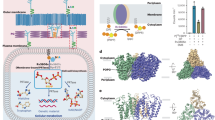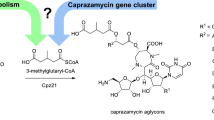Abstract
Decaprenylphosphoryl-d-arabinofuranosyl (DPA), the immediate donor for the polymerized d-Araf residues of mycobacterial arabinan, is synthesized from 5-phosphoribose-1-diphosphate (PRPP) in three-step reactions. (i) PRPP is transferred to decaprenyl-phosphate (DP) to form decaprenylphosphoryl-d-5-phosphoribose (DPPR). (ii) DPPR is dephosphorylated to form decaprenylphosphoryl-d-ribose (DPR). (iii) DPR is formed to DPA by the epimerase. Mycobacterium tuberculosis Rv3806c and heteromeric Rv3790/Rv3791 have been identified as the PRPP: decaprenyl-phosphate 5-phosphoribosyltransferase and the epimerase respectively. Rv3807c, however, as the candidate of phospholipid phosphatase, catalyzing the biosynthesis of decapreny-l-phosphoryl-ribose (DPR) from decaprenylphosphoryl-β-d-5-phosphoribose by dephosphorylating, has no direct experimental evidence of its essentiality in any species of mycobacterium. In this study, Rv3807c gene was amplified from the genome of M. tuberculosis H37Rv by PCR, and was successfully expressed in Escherichia coli BL21 (DE3) via the recombinant plasmid pColdII-Rv3807c. The resulting protein with the 6× His-tag was identified by SDS-PAGE and Western blotting. The protein was predicted through bioinformatics to contain three transmembrane domains, the N-terminal peptide, and a core structure with phosphatidic acid phosphatase type2/haloperoxidase. This study provides biochemical and bioinformatics evidence for the importance of Rv3807c in mycobacteria, and further functional studies will be conducted for validating Rv3807c as a promising phospholipid phosphatase in the synthetic pathway of DPA.





Similar content being viewed by others
Abbreviations
- BCIP:
-
5-Bromo-4-chloro-3-indolylphosphate
- DP:
-
Decaprenyl-phosphate
- DPA:
-
Decaprenyl-phospho-d-arabinose
- DPPR:
-
Decaprenylphosphoryl-d-5-phosphoribose
- DPR:
-
Decaprenylphosphoryl-d-ribose
- NBT:
-
Nitroblue tetrazolium
- Ni-NTA:
-
Ni-nitrilotriacetic acid
- EDTA:
-
Ethylenediaminetetraacetic acid
- PAGE:
-
Polyacrylamide gel electrophoresis
- PRPP:
-
5-Phosphoribose-1-diphosphate
- SDS:
-
Sodium dodecyl sulfate
References
Brennan PJ (2003) Structure, function, and biogenesis of the cell wall of Mycobacterium tuberculosis. Tuberculosis (Edinb) 83(1–3):91–97
Crick DC, Schulbach MC, Zink EE, Macchia M, Barontini S, Besra GS et al (2000) Polyprenyl phosphate biosynthesis in Mycobacterium tuberculosis and Mycobacterium smegmatis. J Bacteriol 182(20):5771–5778
Crick DC, Mahapatra S, Brennan PJ (2001) Biosynthesis of the arabinogalactan–peptidoglycan complex of Mycobacterium tuberculosis. Glycobiology 11(9):107R–118R
Scherman M, Weston A, Duncan K, Whittington A, Upton R, Deng L et al (1995) Biosynthetic origin of mycobacterial cell wall arabinosyl residues. J Bacteriol 177(24):7125–7130
Wolucka BA, McNeil MR, de Hoffmann E, Chojnacki T, Brennan PJ (1994) Recognition of the lipid intermediate for arabinogalactan/arabinomannan biosynthesis and its relation to the mode of action of ethambutol on mycobacteria. J Biol Chem 269(37):23328–23335
Crellin PK, Brammananth R, Coppel RL (2011) Decaprenylphosphoryl-beta-d-ribose 2′-epimerase, the target of benzothiazinones and dinitrobenzamides, is an essential enzyme in Mycobacterium smegmatis. PLoS One 6(2):e16869. doi:10.1371/journal.pone.0016869
Horita Y, Takii T, Kuroishi R, Chiba T, Ogawa K, Kremer L et al (2011) Synthesis and evaluation of anti-tubercular activity of new dithiocarbamate sugar derivatives. Bioorg Med Chem Lett 21(3):899–903. doi:10.1016/j.bmcl.2010.12.084
Buroni S, Pasca MR, de Jesus Lopes Ribeiro AL, Degiacomi G, Molteni E, Riccardi G (2012) Antituberculars which target decaprenylphosphoryl-β-d-ribofuranose 2′-oxidase DprE1: state of art. Appl Microbiol Biotechnol 94(4):907–916. doi:10.1007/s00253-012-4013-4
Huang H, Scherman MS, D’Haeze W, Vereecke D, Holsters M, Crick DC et al (2005) Identification and active expression of the Mycobacterium tuberculosis gene encoding 5-phospho-α-d-ribose-1-diphosphate: decaprenyl-phosphate 5-phosphoribosyltransferase, the first enzyme committed to decaprenylphosphoryl-d-arabinose synthesis. J Biol Chem 280(26):24539–24543. doi:10.1074/jbc.M504068200
Jiang T, He L, Zhan Y, Zang S, Ma Y, Zhao X et al (2011) The effect of MSMEG_6402 gene disruption on the cell wall structure of Mycobacterium smegmatis. Microb Pathog 51(3):156–160. doi:10.1016/j.micpath.2011.04.005
Wolucka BA (2008) Biosynthesis of d-arabinose in mycobacteria—a novel bacterial pathway with implications for antimycobacterial therapy. FEBS J 275(11):2691–2711. doi:10.1111/j.1742-4658.2008.06395.x
Mikusova K, Huang H, Yagi T, Holsters M, Vereecke D, D’Haeze W et al (2005) Decaprenylphosphoryl arabinofuranose, the donor of the d-arabinofuranosyl residues of mycobacterial arabinan, is formed via a two-step epimerization of decaprenylphosphoryl ribose. J Bacteriol 187(23):8020–8025. doi:10.1128/JB.187.23.8020-8025.2005
Eoh H, Brown AC, Buetow L, Hunter WN, Parish T, Kaur D et al (2007) Characterization of the Mycobacterium tuberculosis 4-diphosphocytidyl-2-C-methyl-d-erythritol synthase: potential for drug development. J Bacteriol 189(24):8922–8927. doi:10.1128/JB.00925-07
Sassetti CM, Boyd DH, Rubin EJ (2003) Genes required for mycobacterial growth defined by high density mutagenesis. Mol Microbiol 48(1):77–84
Slayden RA, Jackson M, Zucker J, Ramirez MV, Dawson CC, Crew R et al (2013) Updating and curating metabolic pathways of TB. Tuberculosis (Edinb) 93(1):47–59. doi:10.1016/j.tube.2012.11.001
Carman GM, Han GS (2006) Roles of phosphatidate phosphatase enzymes in lipid metabolism. Trends Biochem Sci 31(12):694–699. doi:10.1016/j.tibs.2006.10.003
Dong X, Bhamidi S, Scherman M, Xin Y, McNeil MR (2006) Development of a quantitative assay for mycobacterial endogenous arabinase and ensuing studies of arabinase levels and arabinan metabolism in Mycobacterium smegmatis. Appl Environ Microbiol 72(4):2601–2605. doi:10.1128/AEM.72.4.2601-2605.2006
Acknowledgments
This study is supported by the grants from National Natural Science Foundation of China (30970647).
Conflict of interest
The authors declare that they have no conflicts of interest.
Author information
Authors and Affiliations
Corresponding author
Rights and permissions
About this article
Cite this article
Cai, L., Zhao, X., Jiang, T. et al. Prokaryotic Expression, Identification and Bioinformatics Analysis of the Mycobacterium tuberculosis Rv3807c Gene Encoding the Putative Enzyme Committed to Decaprenylphosphoryl-d-arabinose Synthesis. Indian J Microbiol 54, 46–51 (2014). https://doi.org/10.1007/s12088-013-0418-8
Received:
Accepted:
Published:
Issue Date:
DOI: https://doi.org/10.1007/s12088-013-0418-8




